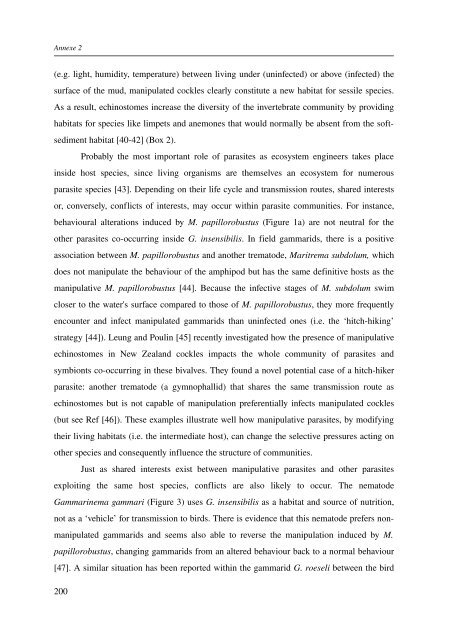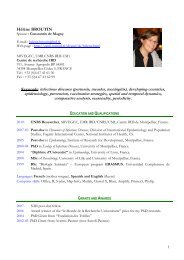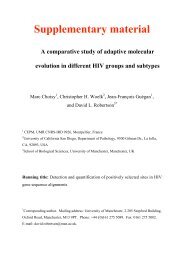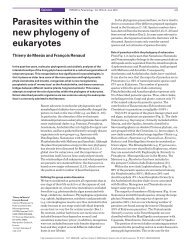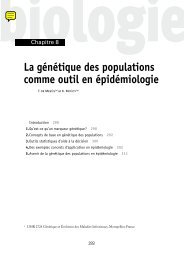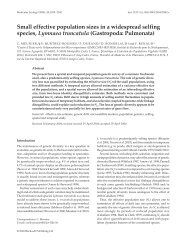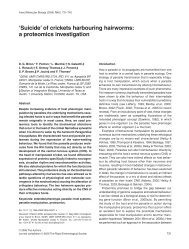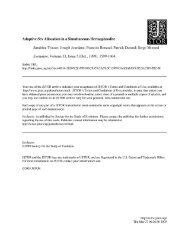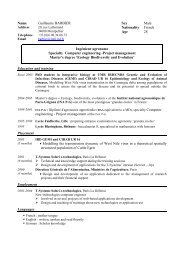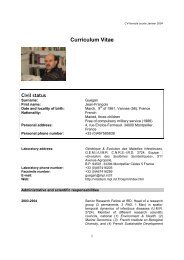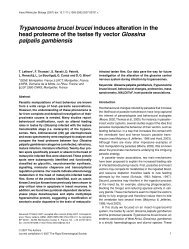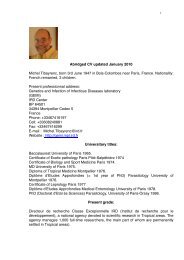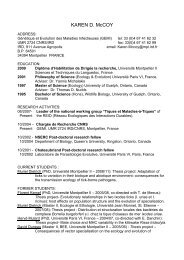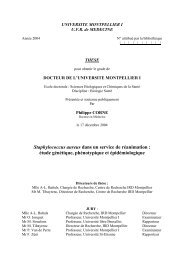écologie des virus influenza aviaires en Camargue - IRD
écologie des virus influenza aviaires en Camargue - IRD
écologie des virus influenza aviaires en Camargue - IRD
Create successful ePaper yourself
Turn your PDF publications into a flip-book with our unique Google optimized e-Paper software.
Annexe 2(e.g. light, humidity, temperature) betwe<strong>en</strong> living under (uninfected) or above (infected) thesurface of the mud, manipulated cockles clearly constitute a new habitat for sessile species.As a result, echinostomes increase the diversity of the invertebrate community by providinghabitats for species like limpets and anemones that would normally be abs<strong>en</strong>t from the softsedim<strong>en</strong>thabitat [4042] (Box 2).Probably the most important role of parasites as ecosystem <strong>en</strong>gineers takes placeinside host species, since living organisms are themselves an ecosystem for numerousparasite species [43]. Dep<strong>en</strong>ding on their life cycle and transmission routes, shared interestsor, conversely, conflicts of interests, may occur within parasite communities. For instance,behavioural alterations induced by M. papillorobustus (Figure 1a) are not neutral for theother parasites cooccurring inside G. ins<strong>en</strong>sibilis. In field gammarids, there is a positiveassociation betwe<strong>en</strong> M. papillorobustus and another trematode, Maritrema subdolum, whichdoes not manipulate the behaviour of the amphipod but has the same definitive hosts as themanipulative M. papillorobustus [44]. Because the infective stages of M. subdolum swimcloser to the water's surface compared to those of M. papillorobustus, they more frequ<strong>en</strong>tly<strong>en</strong>counter and infect manipulated gammarids than uninfected ones (i.e. the ‘hitchhiking’strategy [44]). Leung and Poulin [45] rec<strong>en</strong>tly investigated how the pres<strong>en</strong>ce of manipulativeechinostomes in New Zealand cockles impacts the whole community of parasites andsymbionts cooccurring in these bivalves. They found a novel pot<strong>en</strong>tial case of a hitchhikerparasite: another trematode (a gymnophallid) that shares the same transmission route asechinostomes but is not capable of manipulation prefer<strong>en</strong>tially infects manipulated cockles(but see Ref [46]). These examples illustrate well how manipulative parasites, by modifyingtheir living habitats (i.e. the intermediate host), can change the selective pressures acting onother species and consequ<strong>en</strong>tly influ<strong>en</strong>ce the structure of communities.Just as shared interests exist betwe<strong>en</strong> manipulative parasites and other parasitesexploiting the same host species, conflicts are also likely to occur. The nematodeGammarinema gammari (Figure 3) uses G. ins<strong>en</strong>sibilis as a habitat and source of nutrition,not as a ‘vehicle’ for transmission to birds. There is evid<strong>en</strong>ce that this nematode prefers nonmanipulatedgammarids and seems also able to reverse the manipulation induced by M.papillorobustus, changing gammarids from an altered behaviour back to a normal behaviour[47]. A similar situation has be<strong>en</strong> reported within the gammarid G. roeseli betwe<strong>en</strong> the bird200


